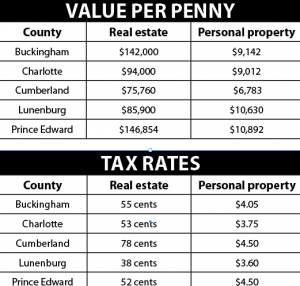Land taxes, values vary widely
Published 12:43 pm Thursday, September 8, 2016
Editor’s Note: Taxes allow local governments across the country to raise the funds needed to provide services to their citizens. But how much is enough? In today’s In-Depth Look, we compare the property tax rates of Buckingham, Charlotte, Cumberland, Lunenburg and Prince Edward counties and what those rates mean to you.
The rates levied on rural localities’ largest source of taxable property widely varies across the Heart of Virginia.
While Cumberland County has the fewest people living in its borders, it has the highest tax rate on real estate at 78 cents per $100 of assessed value. Lunenburg County, which ties with Accomack County for the lowest real estate tax rate in the state, has a levy of 38 cents.
Counties rely heavily on real estate tax collections to fund county operations, especially for public schools.
Buckingham’s real estate tax rate is 55 cents; Charlotte, 53 cents; and Prince Edward — the county with the largest population in the region — 52 cents.
Each year, during the fiscal year budget process, county boards of supervisors re-examine their tax rates — personal property (vehicles), merchant’s capital (business stock), machinery and tools (business equipment) and aircraft. For the most part, the real estate tax rate is the only rate supervisors will adjust, based on two main factors: funding for operational expenses and the reassessment of real property.
The Code of Virginia requires counties to conduct reassessments of land and homes once every four years. In the past 10 years, home and land values have fluctuated, which either increases or decreases what a county gets for its rate since it’s
based on $100 of assessed value.
Boards of supervisors have the option of adopting an equalized rate, or one reflecting the new property values where the changed rate will bring in the same amount of revenue as the rate before the reassessment.
In Cumberland, one penny of real estate tax brings in about $75,760, whereas in Prince Edward County, one penny brings in about $146,854 — just $4,666 shy of double what Cumberland brings in per penny. This is because land and houses are worth much more in Prince Edward.
Buckingham gets about $142,000 per penny of real estate tax, while Charlotte gets about $94,000. Lunenburg gets $85,900 per penny of real estate tax.
The assessed value of $100 on the rate shows the disparity in the values of land, according to the most recent reassessments.
“The board of supervisors and finance committee are committed to keeping tax rates as low as possible,” Lunenburg County Administrator Tracy Gee said. “When cuts come from the state, we strive to find ways to reduce outlay to keep expenses from outweighing revenues. The sale of the landfill to a private entity saved the county millions of dollars due to construction of new cells, closure of the current cell and monitoring expenses (monitoring of our current cell is a minimum period of 50 years). The new Lunenburg Landfill owners accepted those liabilities when they purchased the property. In our efforts to maintain a balanced budget, we have put off some maintenance items and are now looking at the costly endeavor of painting the entire Courthouse Complex at once.”
Cumberland County Administrator and Attorney Vivian Seay Giles offered no comment on the high rates in Cumberland County.
Since 2012, real estate tax rates have slightly changed in each county. Cumberland’s rate has increased by 10 cents from 68 cents per $100 of assessed value, while Lunenburg has increased by two pennies from 36 cents to 38 cents.
From 2009 to 2010, Cumberland’s real estate tax rate jumped from 59 cents to 70 cents — an 11-cent jump in one year — but would eventually be reduced two pennies to 68 cents.
“If I remember correctly, we had a significant reduction in assessed values of property due to a once- every-four-years reassessment,” District One Supervisor Bill Osl, who served on the board at the time, said of the increase. “I believe the rate increase was to remain revenue neutral to the county.”
Since 2014, Buckingham’s rate has increased from 44 cents to 55 cents (11 cents), Charlotte’s has increased from 42 cents to 53 cents (11 cents), and Prince Edward’s has gone from 42 cents to 52 cents (10 cents).
Capital improvement projects, such as new schools and courthouses, reassessments of property, decreasing state funding and program reimbursement and increased costs are among the reasons local governments have used to justify increasing real estate taxes.
Economic activity and actions by the Virginia General Assembly also weigh heavily on a locality’s decision and ability to increase real estate tax rates, which makes it difficult for county administrators and county supervisors to predict how the rates on real estate could change.
“It is impossible for any local government to accurately predict budgetary needs five years out,” said Prince Edward County Administrator Wade Bartlett. “In that time a new reassessment will be completed, real estate values may increase or decrease, depending on economic activity. New businesses may open or existing one close which will either increase or decrease the current revenue streams. I cannot predict actions the General Assembly will take, which may push more expenses down on local governments, which has been the case for the last decade. There are simply too many unknowns to predict if there will be a need to either increase or decrease tax rates.”
Generally, personal property taxes bring in the second most revenue in local taxes.
Cumberland and Prince Edward share the highest personal property tax rates in the area at $4.50 per $100 of assessed value.
The tax is assessed on personal property — such as cars, boats, motorcycles, trailers, buses and motorhomes — housed in the county during the tax year.
To assess the values of vehicles, most commissioners of revenue — the constitutional officer elected as the chief assessment officer for each county — use the NADA Blue Book. Other assessments of personal property are made on fair market value.
Rarely do local governments change their personal property tax rates. The most recent changes include Charlotte increasing its rate from $3 to $3.75 and Prince Edward increasing its rate from $4.20 fo $4.50 in 2008.
Buckingham’s personal property tax rate stands at $4.05, while Lunenburg’s is at $3.60.
Per penny of its personal property tax rate, Prince Edward gets about $10,892, while Cumberland gets about $6,783 — again showing a wide disparity in the values of the vehicles in the two counties despite the localities having the exact same rate.
Buckingham gets $9,142 per penny, Lunenburg gets $10,630 and Charlotte gets $9,012.







